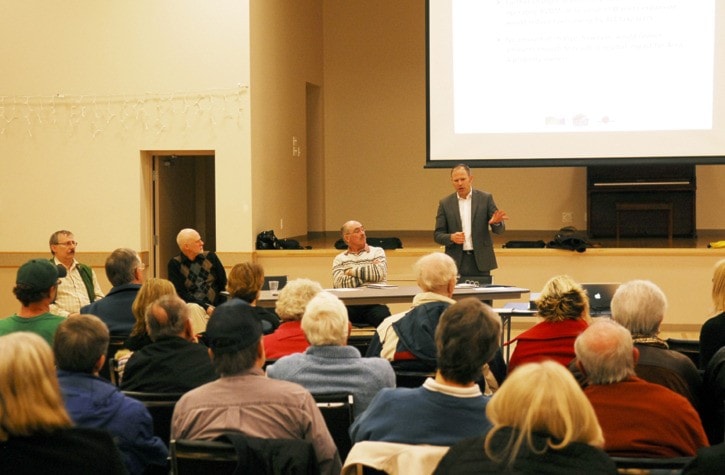Fifty years ago the village of Montrose Leo Leavitt lived in had dirt roads and empty, bushy lots everywhere that provided no end of enjoyment and adventure for a curious young person.
It was an idyllic childhood, people helping each other and building a sense of community in the process — much like the village of Montrose he still calls home 50 years later.
Although he now works as a millwright at Teck in Trail he never wanted to leave the community his father Andy had served as a fireman, and that he now serves as assistant fire chief.
“We have a very great community … we help each other and that is just the way we work in Montrose,” he said. “I just don’t want to live in a community that doesn’t do that.”
And for Leavitt a community that doesn’t do that was proposed on Thursday night in Fruitvale in a public meeting as the villages of Montrose, Fruitvale and Area A (Beaver Valley) hosted a night to explore what amalgamation might mean.
For Leavitt, and several others at the meeting, amalgamation meant losing the community feeling he loved, the village council he said he could approach “at any time,” and a village works department that was “awesome.”
When he stood up and spoke Thursday at the meeting at the Fruitvale Memorial Hall after the consultant’s report was delivered, he was clear that he had nothing against the other communities in the area, he was just content with his.
“I’m fiercely proud of my community and the last thing I want to lose is the identity of my community,” he said, a comment that drew applause from the 100 people who showed up.
Although the evening was intended as information only on the findings of Allan Neilson-Welch Consulting’s High Level Analysis of Amalgamation report, it was obvious many people were against amalgamation — and some were not sure why the matter was even being investigated.
“I’m asking who actually asked for this, who actually initiated it and what is wrong with staying with the status quo?” one woman asked near the end of the public question period.
“There is nothing wrong with staying with the status quo,” said Fruitvale councilor Larry Gray, part of the steering committee struck between the areas to investigate amalgamation.
He said in 2009 there were a lot of questions in the public realm about amalgamation, fueled through the press, and many local politicians agreed a study needed to be done to dispel some of the myths and resolve the discussion.
Area A director Ali Grieve said they decided to get the information — funded by an RDKB grant-in-lieu fund from the Seven Mile Dam — and share that and decide if it was anything worth pursuing.
“It should be recognized that status quo is still one of the options,” she said.
The report revealed that Fruitvale and Montrose taxes would remain about the same or be slightly lowered if amalgamation occurred. However, all classes of taxpayers in Area A of the RDKB would face significant property tax increases — around $300 — if the Beaver Valley communities were to amalgamate.
However, the increases in Area A would not be accompanied with significant service improvements, even though a new amalgamated local government would likely be more efficient.
“There wasn’t anyone who stood up and said ‘Let’s go for this,’ because there isn’t even a significant tax savings for anyone,” she said. “None of us are here to advocate one position or another, we want to present the facts. And the way the facts are presented right now, I don’t see anything I can sell to Area A.”
Grieve said the committee will be taking the findings to the province to show them this was not the outcome they had hoped for, and if there was something they missed — and if there was some way to make Area A’s impact neutral.
They also need more input from the community. People are asked to submit their opinion on the RDKB website at http://www.rdkb.com/HotTopics/BeaverValleyAmalgamation.aspx.
There is a commitment from the province for them to fund a further study on amalgamation, but the communities themselves have to first decide if this is where they want to go.
Each area would have a separate referendum — the date yet to be determined — and it would have to pass in all areas before moving on to the next phase with the province.
Amalgamation by the numbers
• The new boundary of the Beaver Valley District Municipality would include 100 per cent of the village’s population, and 80 per cent of Area A.
• The boundary would include 100 per cent of the two villages’ assessment, and 82 per cent of Area A’s converted assessment.
• The new municipality would take responsibility for all existing municipal services, three existing Beaver Valley services (parks and trails, recreation, arena), local planning, local roads within Area A, as well as animal control, building inspection and the water systems.
• Certain costs were assumed would not change, including Fruitvale and Montrose staffing levels, RDKB service and staffing levels, and inventory of equipment and facilities transferred to the new municipality.
• There would be a reduction of $136,000 in costs — council and administration ($62,300), RDKB administration ($31,200) and other services no longer provided ($42,400).
• Area A would save $114,000 on building inspection, animal control and planning, but lose $272,000 in small communities grants.
• The areas would collectively have to pay an additional $440,800 in local road costs for Area A and lose $50,000 in federal gas tax revenue sharing.
Source: High-level analysis of amalgamation option report
